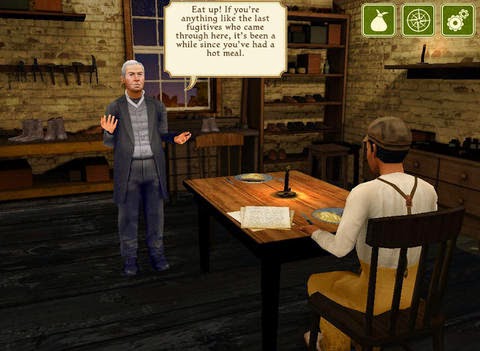The Underground Railroad: Journey to Freedom, developed by Muzzy Lane Software for National
Geographic Education, is one of the Silver Medal Winners of the 2014 International Serious Play Awards.
The Underground Railroad: Journey to Freedom is
an online Serious Game (also available as an iOS app) that
incorporates 3-D experiences as students make a series of choices that affect
their journey from slavery to freedom. Along their journey students encounter
challenges and meet key historical figures who provide help and inspiration.
“In the game, you are a slave. You belong to a
farmer who owns a tobacco plantation on the eastern shore of Maryland. Six long
days a week you tend his field. But not for much longer . . .”
Played from a first-person perspective, in a
choose-your-own-journey style, the game immerses students in the action as they
escape from a southern plantation and head North toward freedom. Along the
route, students will talk to historical figures and get information from
primary source documents, making decisions on their path North that will lead
them to one of several possible outcomes.
The
assessment element is fully integrated with gameplay. As players
make a series of choices that affect their journey from slavery to freedom, the
decisions made along the route determine one of several possible outcomes. As a
result, the game measures and rewards critical thinking.
Avenues
of Escape on the Underground Railroad
Students
can see their progress on a map
The game is designed to be played through once in
about 30 minutes if students are playing independently, and in about 1 hour if
they are playing in small groups or a classroom setting.
There is a detailed teacher's guide for the game that offers suggestions on how to engage students in Grades 6-10 in a variety
of settings, both in and out of the classroom. The educator guide is also a
resource for families. Parents or caregivers can act as facilitators, using the
guide’s background information section as a reference.
Game
Background
The Underground Railroad was a secret network
organized by people who helped men, women, and children escape from slavery to
freedom. It operated before the Civil War (1861-1865) ended slavery in the
United States. The Underground Railroad provided hiding places, food, and often
transportation for the fugitives who were trying to escape slavery. Along the
way, people also provided directions for the safest way to get further north on
the dangerous journey to freedom.
The people who helped slaves escape were called
"conductors" or "engineers." The places along the escape
route were called "stations." Sometimes escaping slaves were called
"passengers." Sometimes they were called "cargo" or
"goods." Conductors helped passengers get from one station to the
next. Sometimes they traveled with escaping slaves all the way from the South,
where they had been slaves, to the North or to Canada, where they would be
free. Sometimes the conductors traveled only a short distance and then handed
the escaping slaves to another helper. Engineers, who were the leaders of the
Underground Railroad, helped slaves who were running away by providing them
with food, shelter, and sometimes jobs. They hid the slaves from people who
were trying to catch them and return them to slavery.
A well-organized network of people, who worked
together in secret, ran the Underground Railroad. The work of the Underground
Railroad resulted in freedom for many men, women, and children. It also helped
undermine the institution of slavery, which was finally ended in the United
States during the Civil War.




